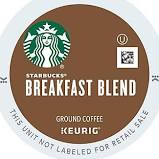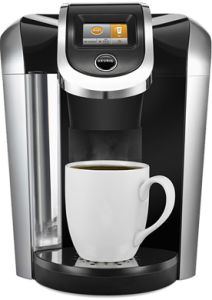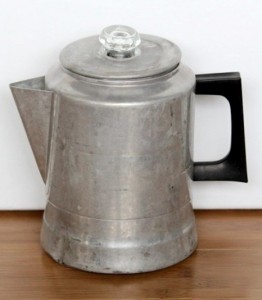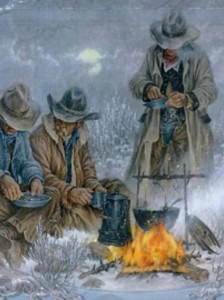I happened to see an ad for an emergency generator on Amazon recently. For whatever reason, I scanned the listing for comments. One person asked, what I suppose, is the pressing question of our modern times: “Will it power a Kuerig?”.
I thought about that for a minute: A winter storm, a blizzard, power out everywhere. Hunkered down, hoping we don’t freeze to death with the heat off. What concerns me the most? How can I get my Kuerig to work?
Don’t get me wrong, I think the Kuerig thing is nifty; cute little cups that make just the right kind of coffee mixture you crave: Starbucks, Folger’s, Green Mountain. Whether its Nantucket Blend or Breakfast Blend, Hazelnut or Sumatran Reserve, it’s all in that little plastic cup. Pop it in the machine and you’re just seconds away from paradise. It’s just not my kind of coffee.
Coffee. I’m a serious coffee drinker, old school type. I started drinking coffee probably around the age of ten. I peaked in my twenties and thirties, when I was drinking a dozen or more cups a day. During my waking hours I was never without a cup of coffee. Back then, we made our coffee like this:
This was called a percolator. Fill it with water, put coffee grinds in the basket inside, put the pot on a stove (or campfire for that matter), and heat the water. The water boiled, pushed up through the grinds, and like magic, coffee! The height of simplicity. No electric, no fancy gadgets, just coffee, water and heat. Coffee was, and still is a simple beverage. Basic. Fundamental. Just ask the old cowboys.
Coffee was also cheap. For many many years a ten cent cup of coffee was standard in many diners. I remember a popular brand was Maxwell House, “Good to the very last drop” coffee. There were of course, other brands, but coffee was coffee. — Well apparently not.
In the late 1980’s, I met a woman from Seattle. She had come to New Jersey and brought her own coffee with her. She was the first “coffee snob” I ever met. She would brew her coffee in her motel room and bring it to a restaurant in a thermos rather than drink the restaurant coffee. She fussed and opined about the wonderful coffee in Seattle, and how backward we were in the rest of the country. I got to taste some of her wonder brew. It was good, but I didn’t see the fuss. I thought she was a bit of a snobby twit, and I think the coffee was Starbucks, which had not yet come East at that time.
The Coffee Shop
According to US News and World Report in a recent article, Americans pay an average of $2.70 for a cup of coffee in a coffee shop, leaving an average 20% tip ($.54), bringing the cost of that cup of coffee to $3.24. So what does that cup off coffee cost the retailer?
Coffee prices have varied over the years, largely due to trade agreements and growing conditions, but since 1976, the wholesale market price of coffee has remained between $.50 and $2.50 per pound. As of this writing, it is selling for $1.46 per pound on the commodities market. The mean price of coffee has been about $1.40 for forty years.
According to the Specialty Coffee Association of America, one pound of coffee should yield 48 six ounce cups. Cutting that in half, we’ll suppose we can get 24 twelve ounce cups ( a Starbucks “tall”) from that pound. At the wholesale level, that’s a cost of about $.06 (six cents) per cup.
From the wholesaler, the coffee must go the the roaster, who roasts, packages, and ships the coffee to the distributor, bringing the cost per pound to around $3.00. Add in miscellaneous costs for loss, shrinkage, other overhead, and profits, and we’re looking at about $6.00 per pound to the coffee shop retailer. That’s $.25, or twenty-five cents per cup.
Of course the coffee shop has lots of costs too; cream, sugar, the cup, napkins, and all the other overhead associated with running a retail business. So if the coffee shop owner doubled his costs (100 percent markup), the coffee would cost the customer fifty cents per cup. If the shop tripled the cost, it would be seventy-five cents, quadrupled it, $1.00 per cup.
Which brings us to the average cost of $2.70 per 12 ounce cup. That’s a markup of almost 1100 percent!
Home Brew
The current price for our Maxwell House ” good to the last drop” coffee is running $6.00 – $8.00 per pound at the retail store. One pound of Starbucks coffee retail is about $15.00.
So let’s recap at this point. If I buy a pound of Maxwell House for, let’s say $7.00 per pound at Walmart and make it at home, it costs me about $.29 (twenty-nine cents) per cup. If I buy a pound of Starbucks and do the same thing, it’s about $.63 (sixty-three cents).
 Which brings us back to Keurig. In order to get a 12 ounce cup (keeping this apples to apples), you must buy the K-Mug pods. The price of these, from the Keurig website are about $14.00 per 12-pack. That makes the cost of your 12 ounce mug of coffee from the Keurig about $1.17 per cup. I couldn’t find Starbucks K-Mug size, so we have to extrapolate a bit, making your 12 ounces of Starbucks K-Mug size about $1.76 per cup.
Which brings us back to Keurig. In order to get a 12 ounce cup (keeping this apples to apples), you must buy the K-Mug pods. The price of these, from the Keurig website are about $14.00 per 12-pack. That makes the cost of your 12 ounce mug of coffee from the Keurig about $1.17 per cup. I couldn’t find Starbucks K-Mug size, so we have to extrapolate a bit, making your 12 ounces of Starbucks K-Mug size about $1.76 per cup.
Before I go any further, let me stipulate to any coffee aficionados or “foodies” out there, I understand the “differences” in coffees — different types of beans, different growing areas, blends, etc. I get it. There is no need to tell me I’m comparing apples to oranges. People are willing to pay premium prices for all kinds of things, and if that is your desire, by all means, pursue it. I’m just painting with broad strokes here.
Here’s how I see the bottom line:
If I drink three cups of my $.25 per cup Maxwell House a day, that’s $.75/day or $273.75 per year.
If you drink 3 cups of $1.76 Keurig Starbucks per day, that’s $5.28 per day or $1927.20 per year.
If you buy 3 cups per day in a coffee shop at the average price of $2.70 per cup, that’s $8.10 per day or $2956.50 per year.
Coffee sales in the United States alone are over $18 billion annually. Americans consume an incredible 400 million cups per day (half the population averages 3 cups/day).
Coffee prices are crazy, but some of the people who buy it are even crazier. A coffee shop in New York City recently opened selling “extraction” coffee (I don’t know what that is, and I don’t care) for as much as $18. per cup. (New York City, Most Expensive Cup of Coffee). Some coffee aficionados are equating these coffee prices with the prices of craft beers, another overpriced commodity. Not to be outdone, Starbucks now has a “Reserve” coffee selling for around $7/cup.
“Starbucks, which introduced millions of people around the world to higher quality coffee and espresso drinks and now must find a way to avoid being labeled pedestrian when compared with upscale rivals like Blue Bottle and Intelligentsia, which are popping up in U.S. cities….” Yahoo News.
And so it goes. That ten cent “cup of Joe” is now a designer product, capable of being sold at extraordinary prices. Enjoy your Kuerig. You might want to consider purchasing a generator to power it if the electric goes off.
Notes:
USA Today – Price of a Cup of Coffee


